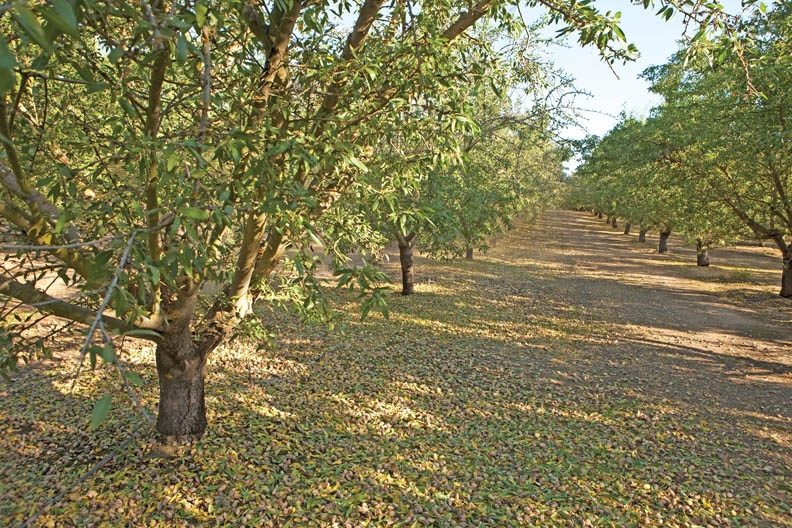
Improved almond spraying reduces pesticide movement
Improving the accuracy and efficacy of spray applications for pest control results not only in better control and more returns to growers, but it can also reduce the environmental impact of almond farming by minimizing off-site movement of pesticides through drift or deposition to the orchard floor.
May 21, 2012

A number of collaborative research studies funded by the Almond Board of California are confirming much of what we already know about improving the efficacy of applied pesticides while reducing off-site movement from the orchard.
Improving the accuracy and efficacy of spray applications for pest control results not only in better control and more returns to growers, but it can also reduce the environmental impact of almond farming by minimizing off-site movement of pesticides through drift or deposition to the orchard floor.
The Almond Board has funded two complementary projects since 2010 that, so far, are showing simple modifications, such as slowing sprayer speeds, reducing spray volume, and modifying nozzle configuration, can significantly improve the efficacy of hullsplit sprays for in-season navel orangeworm control while reducing off-target movement.
Narrow control window
Navel orangeworm (NOW) is the primary insect pest in almonds, but control through in-season sprays has been challenging due to the narrow time frame for treatment combined with the difficulty of achieving adequate insecticide coverage. Newer selective chemistries have become available to almond growers over the last five years to improve in-season options for control of navel orangeworm, but more than ever these selective chemistries require good coverage for optimum control.
Research spearheaded by USDA ARS entomologist Joel Siegel of the Areawide Navel Orangeworm Program has shown that NOW spray efficacy declines significantly in the upper canopy because of the drop-off in spray coverage above 16 feet. Growers should take this into consideration when putting together a NOW control program that includes hullsplit sprays. Siegel’s research is focused in part on finding ways to improve penetration and coverage into the upper canopy.
Mel Machado, fieldman for Blue Diamond Growers in Northern Stanislaus and San Joaquin Counties, says poor sprayer calibration and high speeds are two of the common mistakes he and other Blue Diamond fieldmen see as they visit orchards in the Central Valley.
Especially for pests such as navel orangeworm, where the slightest difference in control can have major implications on razor thin margins for rejects, operating the sprayer at the optimum speed is critical.
Speed adjustment
Siegel’s research demonstrated that a slight speed increase from 2 mph to 2.5 mph reduced insecticide coverage by as much as 32 percent, demonstrating that a slight difference in tractor speed can have a significant impact. Siegel’s research also suggests that the use of two nozzles at each position on a spray rig can significantly improve insecticide coverage and allow the applicator to apply insecticide at a reduced volume.
Ken Giles, with the UC Davis Department of Biological and Agricultural Engineering, is leading complementary studies by a team of researchers with a combined interest in improving pest control economics and efficacy while reducing spray drift and environmental impacts. Giles found that NOW survival rates were three times greater when spray was applied at rig speeds of 2.4 mph compared to 1.8 mph. These differences were most noticeable in nuts obtained from the upper canopy. Off-site spray drift was also slightly higher at the higher rate of speed.
Giles also found benefits at slower speeds in directing two-thirds of the spray volume to the top five nozzles rather than directing that proportion to the top three nozzles.
Lower volume, better efficacy
Lower volume, better efficacy
Giles’ project looks at off-site movement of applied sprays under various spray operations and sprayer configurations. This study finds that reducing spray volume of hullsplit sprays also appears to increase the efficacy of applied sprays while significantly reducing drift and deposition of sprays to the orchard floor, where they may find their way into nearby surface waterways.
He compared hullsplit sprays at a conventional volume of 100 gallons per acre with reduced application volume of 50 gallons per acre applied at the recommended 2-mile-per-hour speed.
Movement of pesticides to the orchard floor was cut in half for the 50 GPA rate versus the 100 GPA spray treatment. Spray drift was also reduced dramatically in the area surrounding the orchard footprint for the 50 GPA spray. Both treatments provided excellent control of NOW up to 14 days after treatment within the lower portion of the canopy. While NOW survival was less than 1 percent one day after treatment in the upper canopy, it was significantly higher two weeks after treatment, ranging from 5 percent to 11 percent, depending on the treatment.
Results from these initial studies suggest that minor changes to ground speed, spray volume, sprayer setup and nozzle configuration can have profound impacts on the efficacy of in-season sprays while improving the environmental stewardship of almond spray programs.
Results of these newer studies will need to be replicated over a number of years and various conditions. But initial findings are encouraging that improved control of navel orangeworm at hullsplit with selective chemistries while reducing environmental impacts is possible without significant changes or investment in capital equipment.
You May Also Like



